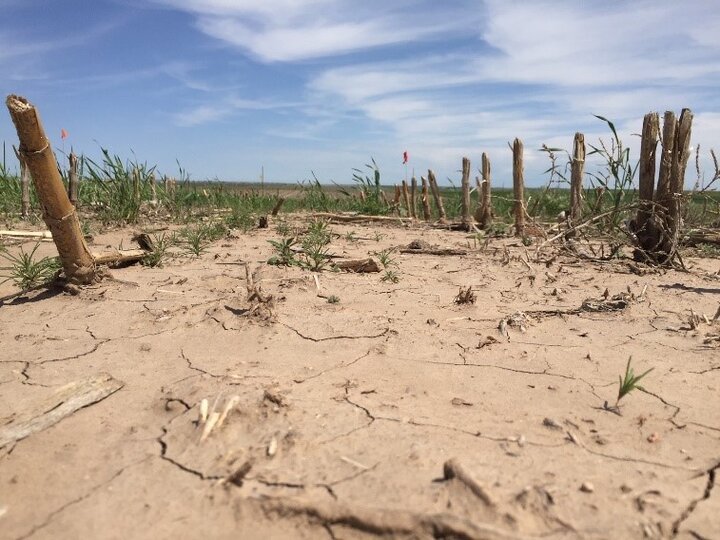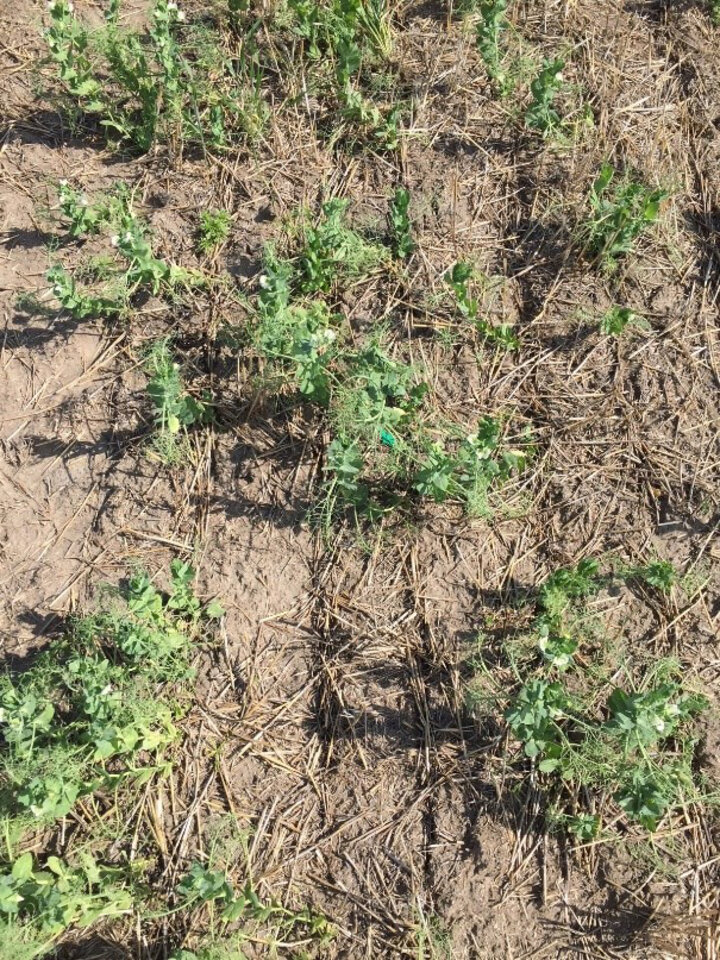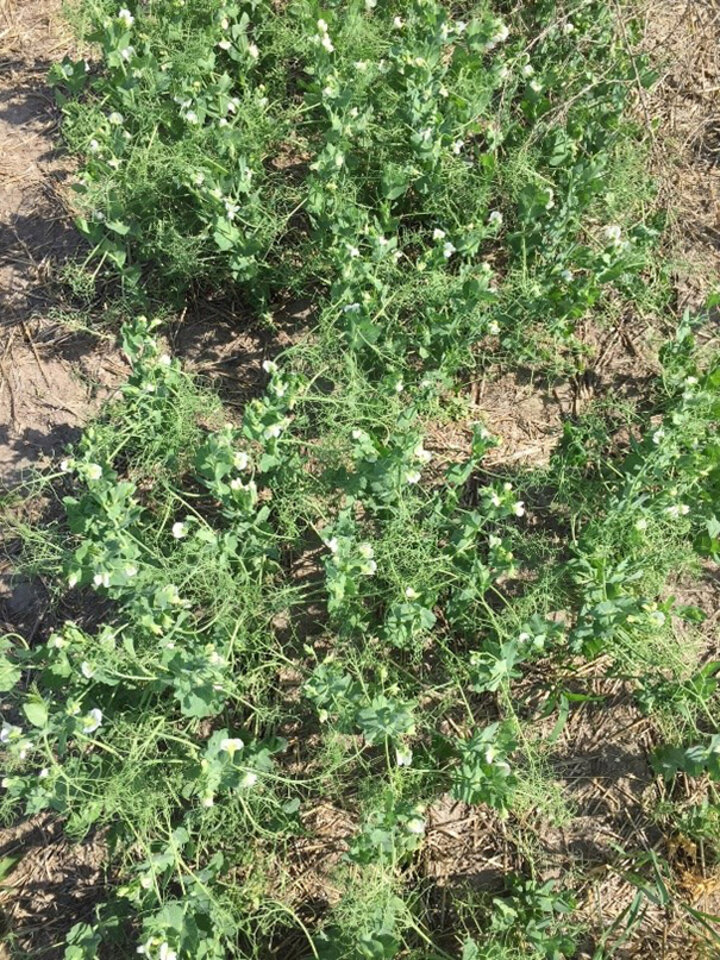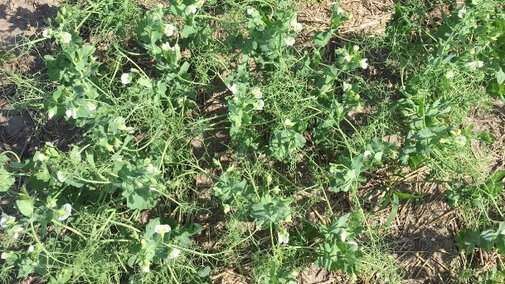Adoption of pulse crops in Nebraska cropping systems, particularly yellow field pea (Pisum sativum L.), has gained popularity recently due to low input requirements, easy establishment, and a growing marketplace demand for plant-based protein sources. In the presence of wheat-corn-fallow rotations, yellow field pea may be able to replace summer fallow to improve land productivity while increasing soil fertility and soil water holding capacity. Yellow field pea acres continue to increase in Nebraska while producers are establishing the crop with planting recommendations from the Northern Great Plains. Producers need specific planting recommendations that are tailored and tested for the Central Great Plains climate.
Replacing Summer Fallow with Field Pea


Rotation Study: Treatment and Design
- Summer fallow versus yellow field pea
- 310,000 plants/acre on 7.5-inch row spacing
- Single field pea variety: Nette 2010
- Sites: North Platte and Sidney
- Planted mid-March
- Harvested mid-July
While wheat-corn-fallow rotations have improved water conservation and reduced soil erosion compared to wheat-fallow, planting yellow field pea is becoming a practice to reduce summer fallow while producing a high-protein cash crop. Integration of yellow field pea may, however, reduce stored soil water and decrease available soil nutrients for the subsequent wheat crop. How much will yellow field pea affect soil fertility and soil water content? To determine the effect that yellow field pea has in this rotation sequence, two field trials were carried out in 2018.
- Field pea was planted at a standard rate of 310,000 plants/acre.
- Soil tests were run on summer fallow and field pea plots after pea harvest; plots were managed under the same conditions during the growing season.
- Soil water content was monitored throughout the growing season every two weeks within similar summer fallow and field pea plots.
- Summer fallow plots contained 47% more water over field pea plots across all soil-water content observations at the Sidney test location.
- Nitrate and soluble salt content was reduced in field pea plots compared to summer fallow plots.
- At harvest, yellow field pea yielded 22 bu/ac at Sidney and 30 bu/ac at North Platte.
The Relationship Between Planting Timing, Population, and Yield


Agronomic Study: Treatment and Design
- Planting dates: early, middle, late
- Five populations: 130,000 - 490,000 seed/ac
- Single field pea variety: Nette 2010
- 7.5-inch row spacing on all treatments
- Planting dates separated by 14 days each
- Five populations
- Fifteen treatment combinations
With yellow field pea gaining acres and popularity in cropping systems across Nebraska, specific planting rate and planting timing recommendations are needed for the Central Great Plains as many current planting recommendations for Nebraska are based on research from Canada and the Northern Great Plains. The current general planting recommendations for western Nebraska suggests planting mid-March at approximately 350,000 seeds/acre. While this recommendation has performed well, there is an opportunity to plant earlier and adjust seeding rates to avoid high temperatures during the reproductive stage while improving plant physiological response from adjusting seeding rates.
- Field pea was planted at three times (early March, mid-March, early April).
- Field pea was planted at five seeding rates (130,000 – 490,000 seed/acre) within each planting time.
- Emergence percentage was measured by collecting stand counts every three days after the first emerged plant and until emergence plateaued.
- The percent of emerged plants compared to planted live seed did not differ across planting times at Sidney but did differ at the Hemingford test site.
- Harvest occurred in mid-July. Plot yield, plant characteristics, and plant samples were collected from each treatment combination.
- Yield components such as seeds/plant, whole plant weight, and seeds/pod were calculated from sampled plants.
- Delayed planting tended to increase yield over early planting by 15% at the Hemingford site and suggested planting timing tended to increase yield over delayed planting by 11% at the Sidney site.
- Across test locations, increasing the seeding rate from 130,000 seeds/acre to 490,000 seeds/acre increased yield approximately 50% across all planting timings.
- Planting date and seeding rate affected the physiological response of field pea in the number of seeds/plant, seeds/pod, and location of pod set on the plant.
While this research has only been conducted one year across western Nebraska, there does appear to be a benefit to incorporating yellow field pea into wheat-corn-fallow crop rotations to replace summer fallow. At the university’s West Central Research and Extension Center, yellow field pea expressed a greater level of microbial activity and nitrogen mineralization over summer fallow while salt content was not different. The effect of field pea on soil fertility may depend on environmental conditions as soil trends between the Sidney and North Platte sites differ.
Integration of field pea into crop rotations can be approached with a multi-year vision for improving ecological parameters such as soil-water holding capacity, soil microbiome, and soil fertility. The use of field pea can be part of a long-term strategy to enhance ecological sustainability while producing a high-protein cash crop. In terms of agronomic recommendations to field pea management, higher seeding rates and later planting timing tended to increase yield in an unusually wet, cold spring climate.

